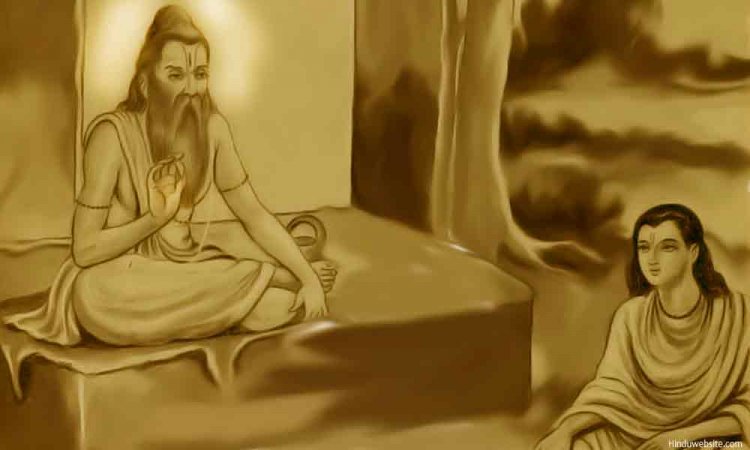The Guru-Disciple Relationship: Lost In Transition

The Indian perspective says that the aim of human life is to grow by inner and outer experience till man lives in god, realises his spirit, becomes divine in knowledge, in will and in the joy of his being. In the course of achieving this transforming experience, the guru holds a special place.
The guru-disciple interaction touches deep and regressed layers of the two main features of the relationship, surrender of the shishya and intimacy with the guru. Real teaching is believed to occur when the disciple has disciplined himself and is tuned to the wavelength of the guru. Teaching, example, and influence play significant roles in mentoring.
One very distinctive characteristic of guru-shishya relationship is its poly-variant nature. It indicates the all-encompassing quality of this relationship. Dynamics of the relationship indicate that its basis was a complete transformation of the shishya by the guru.
In the early oral traditions of the Upanishads, the guru–shishya relationship had evolved into a fundamental component of Hinduism. The term "Upanishad" derives from the Sanskrit words "upa" (near), "ni" (down) and "ṣad" (to sit) - so it means "sitting down near" a spiritual teacher to receive instruction.
The relationship between Krishna and Arjuna in the Bhagavad Gita portion of the Mahabharata, and between Rama and Hanuman in the Ramayana, are examples. In the Upanishads, gurus and disciples appear in a variety of settings (e.g. a husband answering questions about immortality; a teenage boy being taught by Yama, Hinduism's Lord of Death). Sometimes the sages are women, and the instructions may be sought by kings.
In the Vedas, the knowledge of Brahman (brahmavidya) is communicated from guru to shishya by oral lore.
Common characteristics of the guru-shishya relationship
Within the broad spectrum of the Hindu religion, the guru–shishya relationship can be found in numerous variant forms including tantra. Some common elements in this relationship include:
The establishment of a teacher/student relationship.
A formal recognition of this relationship, generally in a structured initiation ceremony where the guru accepts the initiate as a shishya and also accepts responsibility for the spiritual well-being and progress of the new shishya.
Sometimes this initiation process will include the conveying of specific esoteric wisdom and/or meditation techniques.
Gurudakshina, where the shishya gives a gift to the guru as a token of gratitude, often the only monetary or otherwise fee that the student ever gives. Such tokens can be as simple as a piece of fruit or as serious as a thumb, as in the case of Ekalavya and his guru Dronacharya.
Titles of gurus
In paramapara, not only is the immediate guru revered, the three preceding gurus are also worshipped or revered. These are known variously as the kala-guru or as the "four gurus" and are designated as follows:
Guru – the immediate guru
Parama-guru – the guru of the Parampara or specific tradition (e.g. for the Śankaracharyas this is Adi Śankara)
Parātpara-guru – the guru who is the source of knowledge for many traditions (e.g. for the Śankaracharya's this is Vedavyāsa)
Parameṣṭhi-guru – the highest guru, who has the power to bestow mokṣa (usually depicted as Lord Śiva, being the highest guru)
Parampara, Sampradaya and Akhara
Traditionally the word used for a succession of teachers and disciples in ancient Indian culture is parampara. In the parampara system, knowledge (in any field) is believed to be passed down through successive generations. The Sanskrit word figuratively means "an uninterrupted series or succession". Sometimes defined as "the passing down of Vedic knowledge", it is believed to be always entrusted to the ācāryas.
An established parampara is often called sampradāya, or school of thought. For example, in Vaishnavism a number of sampradayas are developed following a single teacher, or an acharya. While some argue for freedom of interpretation others maintain that "Although an ācārya speaks according to the time and circumstance in which he appears, he upholds the original conclusion, or siddhānta, of the Vedic literature."
Akhara is a place of practice with facilities for boarding, lodging and training, both in the context of Indian martial artists or a Sampradaya monastery for religious renunciates.
For example, in the context of the Dashanami Sampradaya sect, the word denotes both martial arts and religious monastic aspects of the trident wielding martial regiment of renunciate sadhus.
Guru–shishya relationship types
There is a variation in the level of authority that may be granted to the guru. The highest is that found in bhakti yoga, and the lowest is in the pranayama forms of yoga such as the Sankara Saranam movement. Between these two there are many variations in degree and form of authority.
Advaita Vedanta
Advaita Vedānta requires anyone seeking to study Advaita Vedānta to do so from a guru (teacher). The guru must have the following qualities:
Śrotriya- must be learned in the Vedic scriptures and sampradaya
Brahmanişţha- figuratively meaning "established in Brahman"; must have realised the oneness of Brahman in everything and in himself.
The seeker must serve the guru and submit his questions with all humility so that doubt may be removed. According to Advaita, the seeker will be able to attain liberation from the cycle of births and deaths (moksha).
Śruti tradition
The guru–shishya tradition plays an important part in the Shruti tradition of Vaidika dharma. The Hindus believe that the Vedas have been handed down through the ages from guru to shishya. The Vedas themselves prescribe for a young brahmachari to be sent to a Gurukul where the Guru (referred to also as acharya) teaches the pupil the Vedas and Vedangas. The pupil is also taught the Prayoga to perform yajnas. The term of stay varies (Manu Smriti says the term may be 12 years, 36 years or 48 years). After the stay at the Gurukul the brahmachari returns home after performing a ceremony called samavartana.
The word Śrauta is derived from the word Śruti meaning that which is heard. The Śrauta tradition is a purely oral handing down of the Vedas, but many modern Vedic scholars make use of books as a teaching tool.
Shaktipat tradition
The guru passes his knowledge to his disciples by virtue of the fact that his purified consciousness enters into the selves of his disciples and communicates its particular characteristic. In this process the disciple is made part of the spiritual family (kula) - a family which is not based on blood relations but on people of the same knowledge.
Bhakti yoga
The best known form of the guru–shishya relationship is that of bhakti. Bhakti (devotion) means surrender to God or guru. Bhakti extends from the simplest expression of devotion to the ego-destroying principle of prapatti, which is total surrender. The bhakti form of the guru–shishya relationship generally incorporates three primary beliefs or practices:
Devotion to the guru as a divine figure or Avatar.
The belief that such a guru has transmitted, or will impart moksha, diksha or shaktipat to the (successful) shishya.
The belief that if the shishya's act of focusing their bhakti upon the guru is sufficiently strong and worthy, then some form of spiritual merit will be gained by the shishya.
Prapatti
In the ego-destroying principle of prapatti (Sanskrit, "Throwing oneself down"), the level of the submission of the will of the shishya to the will of God or the guru is sometimes extreme, and is often coupled with an attitude of personal helplessness, self-effacement and resignation. This doctrine is perhaps best expressed in the teachings of the four Samayacharya saints, who shared a profound and mystical love of Siva expressed by:
- Deep humility and self-effacement, admission of sin and weakness;
- Total surrender to God as the only true refuge; and
- A relationship of lover and beloved known as bridal mysticism, in which the devotee is the bride and Siva the bridegroom.
In its most extreme form it sometimes includes:
The assignment of all or many of the material possessions of the shishya to the guru.
The strict and unconditional adherence by the shishya to all of the commands of the guru. An example is the legend that Karna silently bore the pain of a wasp stinging his thigh so as not to disturb his guru Parashurama.
A system of various titles of implied superiority or deification which the guru assumes, and often requires the shishya to use whenever addressing the guru.
The requirement that the shishya engage in various forms of physical demonstrations of affection towards the guru, such as bowing, kissing the hands or feet of the guru, and sometimes agreeing to various physical punishments as may sometimes be ordered by the guru.
Sometimes the authority of the guru will extend to all aspects of the shishya's life, including sexuality, livelihood, social life, etc.
Often a guru will assert that he or she is capable of leading a shishya directly to the highest possible state of spirituality or consciousness, sometimes referred to within Hinduism as moksha. In the bhakti guru–shishya relationship the guru is often believed to have supernatural powers, leading to the deification of the guru.
Buddhism
In the Pali Buddhist tradition, magae the Bhikkus are also known as Sekhas (SN XLVIII.53 Sekha Sutta). In the Theravada Buddhist tradition, the teacher is a valued and honoured mentor worthy of great respect and a source of inspiration on the path to Enlightenment.
In the Tibetan tradition, however, the teacher is viewed as the very root of spiritual realization and the basis of the entire path. Without the teacher, it is asserted, there can be no experience or insight. The guru is seen as Buddha. In Tibetan texts, emphasis is placed upon praising the virtues of the guru. Tantric teachings include generating visualisations of the guru and making offerings praising the guru.
The guru becomes known as the vajra (figuratively "diamond") guru, the one who is the source of initiation into the tantric deity. The disciple is asked to enter into a series of vows and commitments that ensure the maintenance of the spiritual link with the understanding that to break this link is a serious downfall.
In Vajrayana (tantric Buddhism) as the guru is perceived as the way itself. The guru is not an individual who initiates a person, but the person's own Buddha-nature reflected in the personality of the guru. In return, the disciple is expected to show great devotion to his or her guru, who he or she regards as one who possesses the qualities of a Bodhisattva. A guru is regarded as one which has not only mastered the words of the tradition, but one that with which the student has an intense personal relationship; thus, devotion is seen as the proper attitude toward the guru.
The Dalai Lama, speaking of the importance of the guru, said: "Rely on the teachings to evaluate a guru: Do not have blind faith, but also no blind criticism." He also observed that the term 'living Buddha' is a translation of the Chinese words huo fuo.
Psychological aspects
Rob Preece, in The Wisdom of Imperfection, writes that while the teacher/disciple relationship can be an invaluable and fruitful experience, the process of relating to spiritual teachers also has its hazards.
As other authors had done before him, Preece mentions the notion of transference to explain the manner in which the guru/disciple relationship develops from a more Western psychological perspective. He writes:
“In its simplest sense transference occurs when unconsciously a person endows another with an attribute that actually is projected from within themselves.”
Preece writes that when we transfer an inner quality onto another person we may be giving that person a power over us as a consequence of the projection, carrying the potential for great insight and inspiration, but also the potential for great danger.
In giving this power over to someone else they have a certain hold and influence over us it is hard to resist, while we become enthralled or spellbound by the power of the archetype
Since ancient times, education has been given an important place in our country. The Gurukul tradition is the oldest system in our India. Gurukulam has existed since the Vedic era.
The development and progress of the country can only happen when the education system is right. Education is an important tool to succeed in life and to do something different. The difficult challenges of life can be reduced through this. The knowledge acquired during the education period assures each person about his life.
Now this tradition is ceasing to exist. Let us study through this article that what is the Gurukul tradition, how was education done before and how is the modern education of today's era different from Gurukul system.
What is the Gurukul tradition?
Gurukul means the place or region where the family of the Guru means the family resides. In ancient times, the teacher was considered to be the Guru or Acharya and the students doing education there were considered to be his family.
Acharya used to teach in Gurukul. To enter the Gurukul, it was compulsory to be eight years old and till the age of twenty five people lived here, were educated and followed celibacy.
Students gather in Gurukul and learn Vedas from their guru. Regardless of social standards, every student was treated equally. The main objective of the Gurukul was to develop knowledge and focus heavily on education.
Here the education of theology was also taught from the study of theology. There is no doubt that Gurukul is considered as an integral part for yoga practice and Yagya. Here every student learns all kinds of work and only after completion of education, he used to choose his work on the basis of interest and quality.
Gurukul was very active about equal education of women and men. Example: In Uttararamacharit, there is a mention of a woman named Atreyi studying with Love-Kush in Valmiki's ashram. This shows that co-education has been in India since ancient times. The Puranas also narrate the stories of Kahod and Sujata, Rahu and Pramdwara. It is known from these that girls were studying with children and they were married when they were young.
Later, the boys and girls had separate gurukuls, just as boys were taught, in the same way girls were also given education, education of scripture and weapons and knowledge of Vedas.
The system of gurukul tradition tells us how excellent was the system of education system in the country, in which there was no difference between the poor and the common man.
Purpose of Gurukul education system
In ancient India, education was imparted only through Gurukul. This method is also called the Guru-Shishya tradition; meant to be:
- Discretion and self-restraint
- Improvement in character
- Friendship or social awareness
- Basic personality and intellectual development
- The spread of virtue
- spiritual growth
- Protection of knowledge and culture
Students in Gurukul were divided into three categories:
1. Vasu - Those who get education till the age of 24 years.
2. Rudra - Those who get education till the age of 36 years.
3. Aditya - Those who get education till the age of 48 years.
Properties of Gurukula system
1. Gurus had vast knowledge and they knew how to direct things i.e. how to teach.
2. This tradition used to take as much time as required and due to this, students used to come out in a subtle form.
3. Students used to achieve a particular style and high level of proficiency.
4. Students respected the Guru and were taught to follow discipline.
5. Most teaching was practical and this style of education had many advantages.
6. The student was given such an environment that the person would become a successful person with the work of his choice.
But in the Gurukul education system, the student does not get much exposure because he stays under the training of the same teacher, there was no day and age designated for the course. With the shelter life in Gurukul, much information about the outside world is not available.
Modern education system
The modern education system has evolved over time and is influenced by the Western system. It has been affected by changes and advances in technology. This education system includes ebooks, video lectures, video charts, 3-D imagery etc. techniques.
There is no doubt that the modern education system has evolved to include technological development. Through these techniques, students are able to sit at home and understand knowledge in a better way, which increases memory. Teaching methods are constantly being upgraded according to advanced research and development.
The only drawback of this education system is that it emphasizes the theoretical part rather than the practical part. When it comes to retention, understanding and opportunities, no one can deny that modern education is more effective. Also, this education system should be made available to everyone so that everyone can use it according to their interest.
Therefore, there is no doubt that there is a need to integrate both education systems. We need to understand the Gurukul, how it works, what the society looked like in the past and how the purpose of Gurukul training can be fulfilled in the present. It is not just to know the past.
Coordination of both education systems is mandatory. We cannot forget that Gurukul system was the only education system of that time. Through this system, students were taught the necessary aspects for a cultured and disciplined life along with education. The students lived together under the Gurukul roof and there was a good humanity, love and discipline. Here, students are taught good habits of respecting elders, mothers, fathers and teachers.
The Gurukul education system of ancient times cannot be forgotten where culture, culture and etiquette and civilization were taught.
Today, on Guru Nanak Jayanti, let’s remember Guru Nanak and Bhai Mardan; for they represent the real essence of the Guru-Shishya relationship.
Haroon Khalid, who is the author of Imagining Lahore and Walking with Nanak, writes:
When they reached Hassan Abdal, a town west of today’s Islamabad, Bhai Mardana is believed to have complained to Guru Nanak of thirst. Using his miraculous powers, the first Sikh guru told his lifelong companion to climb atop the mound overlooking the town where a Muslim sufi, Wali Qandhari, lived by a pool. The sufi was about to give Mardana water, the Sikh legend goes, when he learned the visitor was accompanying another saint. Jealous, he mocked Mardana and asked him to have Nanak arrange for water if he were such a powerful saint. In spite of Qandhari’s rejection, Nanak has Mardana trek up twice more, to no avail. Nanak eventually makes water gush out from under his feet, deprives Qandhari of his water, and stops a boulder thrown at him from atop the hill with a bare hand, leaving his handprint on it.
There are many such stories of saints doubting the miraculous powers of Nanak or showing hubris before they are confronted and humbled by the guru. In Sialkot, Nanak is believed to have chastened the arrogant Hamza Ghous, who had taken it upon himself to destroy the ancient city. Not far from there, at Pasrur, Nanak is said to have encountered another sufi saint, Mian Mitha, and bested him in his knowledge of Islam.
The Janamsakhis, which are essentially Nanak’s hagiographies, are replete with stories showing Mardana’s unquestioned devotion to his guru. When Nanak moved to Sultanpur Lodhi for work after his marriage, Mardana followed him. He was with Nanak when he went on his first udasi, or journey, and when Nanak, after over two decades of travel, returned to Punjab. In some narratives of Nanak’s life, Mardana dies on their return journey, while others suggest he settled with Nanak at Kartarpur, where he died.
It is one Janamsakhi story connected to Mardana that captures the essence of Nanak’s teachings. Mardana is once said to have asked Nanak about his religion so he could convert to it. Nanak responded that if one were a Muslim, he should strive to be a good Muslim; if he were a Hindu, he should become a good Hindu. That is how anyone could become Nanak’s Sikh, his disciple. So, in a way, by remaining Muslim, Mardana became the first Sikh. Sikhism, of course, was still far from being an institutionalised religion. Nanak’s religion was as flexible as Mardana’s identity: a Muslim who was also a Sikh.
Not merely teacher and disciple
In the Janamsakhis, Mardana’s character is deployed to portray Nanak the teacher. It is in teaching Mardana that Nanak teaches his followers. He also serves as the symbol of the fragile humanity in contrast to which Nanak’s spirituality is established. While travelling together, it is always Mardana who feels thirsty, hungry or tired; Nanak exhibits none of these human characteristics. Iqbal Qaiser, a Punjabi poet, feels that Mardana symbolises the material world and Nanak the spiritual. In Nanak’s philosophy, the two are wedded. He exhorts his followers to strike a balance between the two, for going to the extreme on either side is a distraction.
In reality, though, Nanak’s relationship with Mardana may have been more complicated than that of teacher-disciple as depicted in the Janamsakhis. In his biography of the Sikh guru, Harsh Dhillon describes how Nanak, the scion of the Bedi clan, the reciters of the Vedas, learned classical ragas and Hindu devotional songs from Mardana, a Muslim Mirasi.
The Mirasi – the word is derived from “miras”, meaning inheritance – were bards who went village to village singing folk and devotional songs. They also accompanied warriors into battle, singing songs about the bravery of their ancestors. In addition, they memorised the pedigrees of prominent families of their regions. For their knowledge of family histories, they were sometimes called to resolve property conflicts. Unlike the Bedis, who were upper caste, the Mirasis were considered lower caste. Indeed, in contemporary Punjab, Mirasi is used as a caste slur.
Thus, while Nanak was the spiritual teacher, Mardana was the music teacher. And music played an instrumental role in the preaching and development of Sikhism. Nanak taught through his poetry, which he sung to Mardana playing the rubab. It took Nanak’s message to thousands of people during his lifetime, and millions afterwards. Nanak and Mardana founded the tradition of kirtan, which was institutionalised by the later gurus. From Nanak until Partition, following in the tradition of Mardana, it was Muslim rubab players who performed kirtan in gurdwaras.
In the Guru Granth Sahib, the holy book of Sikhism, the verses are accompanied by the ragas in which they should be sung – ragas that were first taught to Nanak by Mardana.
As Sikhism developed, Mardana came to acquire great significance. His caste became insignificant to the new religion, and by implication the very notion of a caste hierarchy. His poetry, along with that of later Sikh gurus, was included in the Guru Granth Sahib. An image of Mardana holding the rubab became ubiquitous to Nanak’s depictions; his presence essential to Nanak’s stories.
Thus, the story of Bhai Mardana became the story of Guru Nanak: the eternal and true Guru-Disciple bond!















































